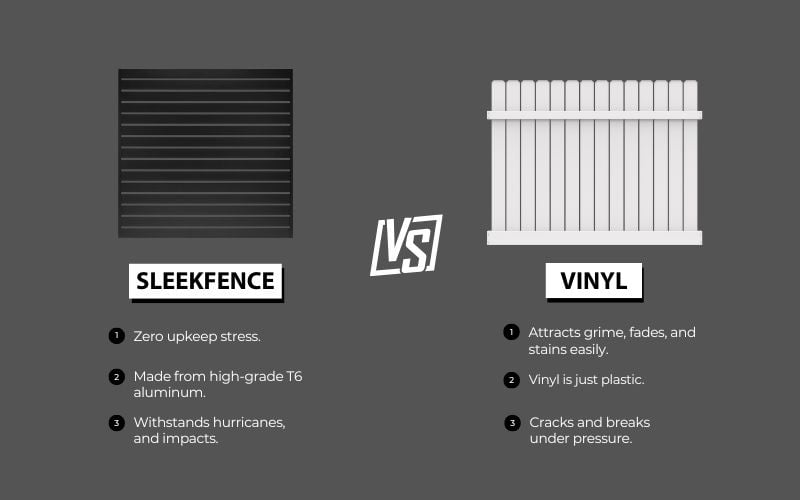Vinyl vs. Aluminum Fencing 2025.
Are you in the market for a new fence? If you’re choosing between aluminum and vinyl fencing, you’re already on the right track: both offer a clean look and don’t rot like wood or rust like iron. But here’s the thing: aluminum doesn’t just match vinyl. It outperforms it in every way that matters. It’s stronger, easier to clean, and holds up better in heat, wind, and time. And while vinyl might seem cheaper up front, it can cost over $31,000 over 50 years once you factor in maintenance and replacement.
Aluminum? Just $24,000. That’s not just a cost savings—it’s your weekends back. Less cleaning, fewer repairs, and more time for what actually matters. Let’s break down the real differences between vinyl vs. aluminum fencing so you can invest with confidence.
Which fence lasts longer? Comparing the durability of vinyl vs. aluminum fencing.
Vinyl: Prone to wear, warping, and weather damage.
Vinyl fencing may be marketed as low-maintenance, but that doesn’t mean it’s built to last. Because it’s made from plastic, vinyl is inherently weaker than aluminum, especially when exposed to the elements. It has a slightly porous surface that attracts dust, moisture, and grime, which makes it harder to keep clean and more likely to show its age. Over time, exposure to wind, hail, and shifting temperatures can make the boards brittle. Cracks and breakage are common, especially in colder climates or storm-prone areas where panels may even blow off entirely.
Vinyl also struggles with heat. In hotter regions or wildfire-prone areas, it can melt and release toxic fumes. Dark-colored vinyl absorbs more sunlight, which accelerates damage and limits your color options. This is why you rarely see black vinyl fences. Even without direct flame exposure, extreme heat can cause panels to warp, sag, or shift out of alignment.
Aluminum: Strong, stable, and built to last
Aluminum fencing is far more durable across the board. It doesn’t warp, crack, or weaken in extreme temperatures. It handles high winds and heavy impacts with ease, staying straight and stable for decades. Powder-coated aluminum is also non-porous, meaning it won’t attract dirt or mildew the way vinyl does. And unlike vinyl, it’s safe to use in wildfire zones and won’t melt or release harmful fumes. Whether you’re dealing with summer heat or winter storms, aluminum fencing will handle anything thrown at it.
Is vinyl or aluminum fencing easier to maintain?
Both aluminum and vinyl fencing are marketed as low-maintenance alternatives to wood and iron. But when it comes to real-world upkeep, the difference between the two becomes clear.
Vinyl: More upkeep than you might expect.
Vinyl fencing may not require painting or sealing, but that doesn’t mean it stays clean on its own. Its slightly porous texture tends to attract dirt, dust, and mildew, especially in humid or dusty climates. Homeowners often find themselves scrubbing vinyl panels several times a year just to keep them looking presentable.
If not regularly maintained, vinyl fences can permanently warp, sag, or fade. A mix of water and bleach is often recommended for deeper cleaning, typically applied with a pressure washer—but repeated pressure washing can accelerate surface damage if not done carefully, leading to brittle, weakened panels over time.
Aluminum: Truly low-maintenance, year after year.
Aluminum, on the other hand, is as low-maintenance as it gets. Powder-coated aluminum fencing like SLEEKFENCE has a smooth, non-porous finish that resists buildup and rinses clean with minimal effort. There’s no need for bleach, scrubbing, or pressure washing—in fact, pressure washers can damage the powder coating and are not recommended. A light rinse with car soap and water is all it takes to restore its original appearance.
Even after years of exposure to sun, wind, rain, or snow, aluminum fences won’t fade, stain, or shift. And because aluminum doesn’t absorb heat or moisture the way vinyl can, it maintains its shape and color with zero intervention. No sealants. No special cleaners. Just a rinse and go. For homeowners who don’t want their weekends eaten up by fence maintenance, aluminum is the clear winner.
What’s the cost difference? Vinyl vs. aluminum fencing over 50 years.
At first glance, vinyl fencing might seem like the more affordable option. Materials and installation usually cost around $8,000, compared to about $21,500 for aluminum fencing. But when it comes to total cost of ownership, vinyl starts to lose its edge.
Vinyl fences require far more maintenance over time. Regular pressure washing with bleach, cleaning off mildew and grime, and replacing damaged panels can add up quickly. Most homeowners end up spending an additional $7,500 on upkeep, bringing the true cost of a vinyl fence to around $15,500.
Aluminum fencing, on the other hand, is a true long-term investment. With almost no maintenance beyond an occasional rinse, the maintenance cost averages just $100 a year, making the total cost for an aluminum fence around $24,000 after 25 years, or $26,500 after 50. Plus, aluminum resists fading, warping, and structural damage without the need for heavy upkeep.
If you live in a mild climate with little sunlight, wind, or dirt, and you’re willing to spend hours each season scrubbing your vinyl fence, you might be able to stretch its lifespan. But for most homeowners, real-world conditions mean a vinyl fence will need full replacement within 50 years. That means your $15,500 investment goes down the drain—and you will need to spend another $15,500 to replace your vinyl fence, bringing the total cost to $31,000 after 50 years. Aluminum fencing is built to last decades longer, saving you time, money, and hassle in the long run.
Conclusion: why aluminum fencing is a better long-term investment than vinyl.
When it comes to strength, maintenance, and long-term value, aluminum fencing is simply the better choice. Vinyl may seem appealing at first, but real-world conditions reveal its weaknesses over time. For a fence that stays clean, stands strong, and looks great for decades, aluminum is the clear winner.
Ready to take the next step? Contact us for a quote—we’re here to help you get the most out of your next fencing project.

